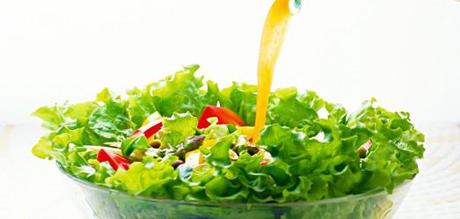
Ever noticed how even the most bland tasting foods can taste incredible with the right dressing? In this blog, I’m going to teach you how to make a killer dressing so food is never boring again! Remember this… F.A.S.S, which stands for Fat – Acid – Sugar – Salt. When these four components are mixed properly, they form a beautiful dressing, tantalizing our taste buds in a range of ways.
At the Food as Medicine course I attended in June, Rebecca Katz, author two excellent cookbooks: One Bite at a Time and The Cancer-Fighting Kitchen, broke down how each element acts:
- FAT: Good fats are like tiny magic carpets that traverse the mouth and carry succulent flavours across our palettes. They lay the foundation—the taste bud superhighway, if you will—that links the otherwise disparate areas of our mouth that sense flavours.
- i.e. Olive oil, coconut oil, macadamia oil, flaxseed oil, butter, avocado.
- ACID: Sour in taste, acids chemically catalyze food; they’re actually nature’s vacuum cleaners, powerfully drawing out hidden flavours. Lemons and limes are common culinary acids used to draw out and brighten flavours.
- i.e. Vinegar, lime, lemon, grapefruit, tamarind, sumac, tomatoes, pickles.
- SALT: The taste bud equivalent of dynamite, salt—used properly—can help flavor explode on the palette. Salt’s crystalline nature, its rough texture, works like a scrubbing bubble that scratches the surface of foods allowing their flavours to be released. The key to salting food is NEVER to do it in one shot, but rather in tiny increments throughout the cooking process.
- i.e. Tamari/soy sauce, rock salt, anchovies, olive paste, fish sauce
- SWEET: The leader of the pack, sweet tastes are the first to hit the palette, and, like the leading edge of a wave that hits the shore, spreads flavours quickly around the mouth while taking the hard edge off many tastes.
- i.e. Maple syrup, sweet balsamic vinegar, honey, coconut paste, raw sugar, palm sugar, pureed fruit, caramelised onions
The bonus is that making a dressing gets the FIRST stage of digestion happening… the CEPHALIC phase. This is the phase which is so often missed. Spices, herbs, and aromatics from the allium family: garlic, onion, shallots, leeks, and chives are incredibly stimulating to the mouth, nose, and eyes; offering a culinary telegram to the brain consisting of three words: TIME TO EAT!
Now, if you run into trouble, here are some tips:
- Too spicy? Add some sweetness or creaminess (dairy cuts heat)
- Too sweet? Add some sour or heat (cayenne, red pepper flakes, chili powder, curry, mustard, black pepper, coriander)
- Too sour? Add sweet
- Too bland? Add salt or some heat
- Too salty? Add sour. A sliced raw potato cooked in the dish for a few minutes then discarded can help absorb excess salt
- Just needs a spark? Add acid or one of the aromatics added at the end of cooking, or just a touch of heat
- Need more depth? Start with aromatics next time (or sauté them separately and add to the dish later)
- Too harsh? Try just a touch of sweetness, such as 1/4 tsp Grade B maple syrup to a pot of soup.
Interestingly, the very strategies that create outstanding flavor also increase the nutritional value of a dish. Gram for gram, there’s nothing more powerful to stimulate and satisfy taste than herbs and spices, and the healing power of these herbs and spices is pretty incredible too. The last ten years have seen numerous aromatic ingredients go under the microscope, very often yielding positive and exciting results.
Having an amazing dressing can make even the dullest of salads POP! No meal needs to ever be boring again, and healthy food can taste DELICIOUS if it’s prepared in the right way :)
Until next time, Stacey.
